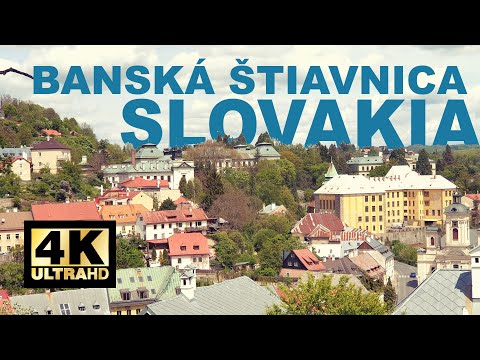Banská Štiavnica, Slovakia in UHD 4k

Banská Štiavnica is a town in central Slovakia, in the middle of an immense caldera created by the collapse of an ancient volcano. Banská Štiavnica has a population of more than 10,000. It is a completely preserved medieval town. Because of their historical value, the town and its surroundings were proclaimed by the UNESCO to be a World Heritage Site on December 11, 1993. The fate of Banská Štiavnica has been closely linked to the exploitation of its abundant resources of silver ore.
The first mining settlement was founded by Celts in the 3rd century BC. It was probably occupied by the Celtic tribe - Cotini. The local population gave the name „Štiavnica“ (acidic stream) to the settlement in the valley, and the settlement on the hill above (Ligotavá hora, or Glanzenberg – the shiny mountain) came to be called „Bana“ (the mine). Banská Štiavnica gained the status of a royal town in 1238, as one of the first towns in the Kingdom of Hungary. Old Castle is considered a “stone chronicle of the town“.
Its walls are the gate to the oldest secrets of Štiavnica. Long ago it used to be a church, but it was transformed into a fortress during the period of Turkish thread. It is a place of the exhibition about the oldest region’s history called “Miners Are Coming”.
The exhibition of shooting targets, smithery, the famous pipe workshop or the exhibition of Baroque sculpture and Calvary in Asylum. The tower also offers an attractive view and some exemplars of historical clockwork. You can taste the atmosphere of a medieval dungeon in the tower of Himmelreich. For many centuries people used to meditate as well as decide the fate of the town behind the stone walls of Old Castle. In the 15th century the Church and the cemetery were surrounded by a wall and in 1540’s it was transformed into a fortress protecting people against Turks.
The Chapel of St. Michal in the Old Castle is also very interesting. The part above ground was called carnarium and the part underground – ossuary. Ossuary was a storage place for non-rotten bones found when digging new graves. In the High and Late Middle Ages, the town was the main producer of silver and gold in the Kingdom of Hungary. During the Ottoman Wars, the Turks made concerted efforts to conquer rich mining towns in Upper Hungary.
This new threat led Banská Štiavnica to build powerful fortifications, including two castles, in the 16th century. The Old Castle, we saw earlier, and the New Castle, which we will see later. As one of the most important centers of the Protestant Reformation in the country, the town belonged to the Protestant "League of Seven Mining Towns". Members of the League were Banská Belá, Banská Bystrica, Kremnica, Ľubietová, Nová Baňa, and Pukanec.
The town was also a leading center of innovation in the mining industry. In 1627, gunpowder was used there in a mine for one of the first times in the world. Holy Trinity Square used to be the centre of the town. The palaces of the richest miners as well as the Church of St. Catherine were located here. The main town’s square was created at the beginning of the 16th century and it is lined by Renaissance-Baroque palaces of wealthy townsmen. Berggericht – the mining court was located on the lower side of the square.
Plague column with Holy Trinity sculpture dominate the centre of the square. It was built as a symbol of gratitude for the retreat of plague epidemic, which had killed more than a half of the town’s population in 1710. Sculptures of six saints – protectors and patrons of miners are placed on its pedestal.
A sculpture depicting history of Banská Štiavnica can be found at the historic town hall. Its author is an academic sculptor, ceramicist, Vlado Oravec. The late Gothic St. Catherine’s Church is one of the most beautiful churches in Banská Štiavnica. It is also called “Slovak”, because the sermons here had been taking place in Slovak language since 1658. St. Catherine’s Church was built in 1488-1491. Trottoir - At least a very little of Štiavnica is like Paris.
Trottoir is an elevated pavement which surrounds the main street of Štiavnica, ending at the statue of Andrej Kmeť. There always used to be small shops, cafés on Trottoir , a “promenade” was full of life. Now it starts to remind the old busy times again. The church of the Assumption of Virgin Mary, also known as “German church” or parish church, is the oldest extant church in the city It was built in ca. 1222 as a three-nave Romanesque basilica.
Already in the early medieval period, Banská Štiavnica was turning into a big, lively town with a high concentration of beggars and outcasts. For that reason, Dominicans decided to aid the city. Already in the 13th century, they built a beautiful Romanesque church of St. Nicolas (presently the parish church of the Assumption of Virgin Mary), as well as a monastery. The Mining Academy was a technological university founded in 1735 by scientist Sámuel Mikoviny. Its original name was Bergschule (Berg Schola), and it has had formal status as an academy since December 13, 1762. At this date, it was established by Empress Maria Theresa in order to train specialists in silver, gold mining and metallurgy The Mining Academy was the cradle of chemical research in Hungary, but its reputation spread beyond the country's border.
As mining was consuming a huge amount of wood and the hills around were totally deforested up to the southern areas near villages. The Department of Forestry was established under the Mining Academy. Representative area with school palaces and the botanical garden was built here at the turn of the 19th and 20th centuries. Andrej Kmeť was a Slovak botanist, ethnographer, archaeologist, and geologist. He identified several new species of plants and created a herbarium with 72,000 specimens. He was one of the first researchers who carried on modern archaeological excavations in Central Europe.
In 1892, he founded the Slovak Learned Society, which later became nucleus of the Slovak Academy of Sciences. He was also known for his bitter criticism of alcoholism. Andrej Kmeť was interred in the National Cemetery in Martin. Glanzenberg, meaning Sparkling Hill, isn’t just the name of a hill above the town. It’s also the name of a hereditary mining tunnel – one of the oldest in the Banská Štiavnica region. The oldest record on it is from 1560. Hereditary mining tunnels were used for draining the tunnels.
They were called “hereditary”, because they had been built by several generations of miners. The longest one was about 16 km long. For many years it used to be the longest underground tunnel of Europe. It is drilled just several meters under the main road, and got famous because of numerous rulers and emperors of Vienna court, who had visited it. Untypical building with an interesting history on the hill is the Old Castle. The white Renaissance fortress towering on the Frauenberg Hill also called Ladies' Hill Its silhouette is unique in Europe; it reminds a rocket.
New Castle – a national cultural monument – is a six-floor Renaissance building with four bastions. The New castle overlooking the city used be part of the fortification system and one of the important watchtowers. Because of its dominant position, it was also used as the town's live clock (exact time was announced every quarter of an hour on a trumpet). Nowadays it explains the history of the Turkish invasions in the 16th century and its influence on the life of mining towns. For unimaginable 150 years the Turkish threat was a day-to-day reality of the Štiavnica region.
It was constructed in 1564–1571 as a watch tower during the Ottoman wars. New Castle was opened to the public as a museum in 1971; the permanent exhibition is located on the 4 floors. The heart is painted on the surface of the tree, not carved.. No harm was done to the tree. :) The highest floor of the Castle offers a panoramic view of Banská Štiavnica and its environs. From this watchtower the watchers called “vartáši” [uarta:shee] used to warn of the danger observed by smoke Morse code signals by day or fire Morse code signals at night. The signals were passed from a hill to a hill, from town to town.
By the way, such as tempting target as Stiavnica – the Silver city - was never conquered. Culture found its place in the town. It's a backdrop of film and music festivals, craft markets and workshops. Štiavnica has a soul of an artist.
2021-06-07 23:18


